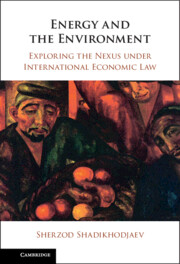Book contents
- Energy and the Environment
- Energy and the Environment
- Copyright page
- Dedication
- Contents
- Figures
- Tables
- Table of Cases
- Table of Treaties
- Table of Other Legal Texts (and Drafts)
- Abbreviations
- Introduction
- 1 Foundations of the Energy–Environment Nexus and International Economic Law
- 2 Energy Trade Control and Environmental Protection
- 3 Energy Subsidies and the Environment
- 4 Pro-environmental Energy Standards and Trade
- 5 Energy Investment Regulation and the Environment
- 6 Energy and Green Technologies
- Conclusion
- Book part
- Bibliography
- Index
6 - Energy and Green Technologies
Published online by Cambridge University Press: 30 April 2024
- Energy and the Environment
- Energy and the Environment
- Copyright page
- Dedication
- Contents
- Figures
- Tables
- Table of Cases
- Table of Treaties
- Table of Other Legal Texts (and Drafts)
- Abbreviations
- Introduction
- 1 Foundations of the Energy–Environment Nexus and International Economic Law
- 2 Energy Trade Control and Environmental Protection
- 3 Energy Subsidies and the Environment
- 4 Pro-environmental Energy Standards and Trade
- 5 Energy Investment Regulation and the Environment
- 6 Energy and Green Technologies
- Conclusion
- Book part
- Bibliography
- Index
Summary
Energy technologies are ‘the combination of hardware, techniques, skills, methods and processes’ involved in ‘producing, transforming, storing, transporting and using energy’. The IEA database captures over 500 mature and immature ‘clean energy’ technologies worldwide that contribute to achieving the goal of net-zero emissions. This chapter will show that international economic law is applicable to government interventions in even the early stages of technology development. For example, State-imposed R&D investment obligations may be banned by IIA provisions on performance requirements, and public incentives for R&D may be disciplined by WTO subsidy rules. Once commercialized, green technologies can reach foreign markets due to international trade and technology transfers that fall within the scope of international economic rules. Reducing trade barriers to environmental goods and services could give a further boost to the international movement of energy-related green technologies. While the importance of green technology transfers between countries is widely recognized, trade and investment rules must be consulted when imposing technology transfer measures.
Keywords
- Type
- Chapter
- Information
- Energy and the EnvironmentExploring the Nexus under International Economic Law, pp. 222 - 266Publisher: Cambridge University PressPrint publication year: 2024

